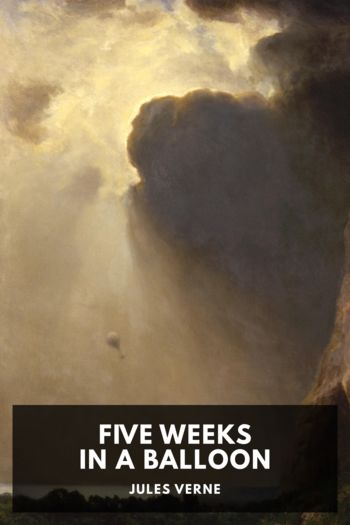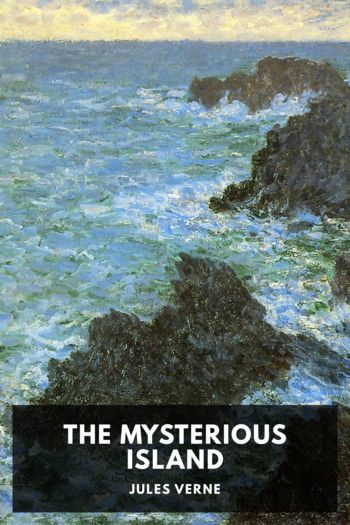Five Weeks in a Balloon, Jules Verne [best interesting books to read TXT] 📗

- Author: Jules Verne
Book online «Five Weeks in a Balloon, Jules Verne [best interesting books to read TXT] 📗». Author Jules Verne
But, when about to land the balloon, the consul was informed that the population of the island would oppose their doing so by force. Nothing is so blind as fanatical passion. The news of the arrival of a Christian, who was to ascend into the air, was received with rage. The negroes, more exasperated than the Arabs, saw in this project an attack upon their religion. They took it into their heads that some mischief was meant to the sun and the moon. Now, these two luminaries are objects of veneration to the African tribes, and they determined to oppose so sacrilegious an enterprise.
The consul, informed of their intentions, conferred with Dr. Ferguson and Captain Bennet on the subject. The latter was unwilling to yield to threats, but his friend dissuaded him from any idea of violent retaliation.
“We shall certainly come out winners,” he said. “Even the imam’s soldiers will lend us a hand, if we need it. But, my dear captain, an accident may happen in a moment, and it would require but one unlucky blow to do the balloon an irreparable injury, so that the trip would be totally defeated; therefore we must act with the greatest caution.”
“But what are we to do? If we land on the coast of Africa, we shall encounter the same difficulties. What are we to do?”
“Nothing is more simple,” replied the consul. “You observe those small islands outside of the port; land your balloon on one of them; surround it with a guard of sailors, and you will have no risk to run.”
“Just the thing!” said the doctor, “and we shall be entirely at our ease in completing our preparations.”
The captain yielded to these suggestions, and the Resolute was headed for the island of Koumbeni. During the morning of the 16th April, the balloon was placed in safety in the middle of a clearing in the great woods, with which the soil is studded.
Two masts, eighty feet in height, were raised at the same distance from each other. Blocks and tackle, placed at their extremities, afforded the means of elevating the balloon, by the aid of a transverse rope. It was then entirely uninflated. The interior balloon was fastened to the exterior one, in such manner as to be lifted up in the same way. To the lower end of each balloon were fixed the pipes that served to introduce the hydrogen gas.
The whole day, on the 17th, was spent in arranging the apparatus destined to produce the gas; it consisted of some thirty casks, in which the decomposition of water was effected by means of iron-filings and sulphuric acid placed together in a large quantity of the first-named fluid. The hydrogen passed into a huge central cask, after having been washed on the way, and thence into each balloon by the conduit-pipes. In this manner each of them received a certain accurately-ascertained quantity of gas. For this purpose, there had to be employed eighteen hundred and sixty-six pounds of sulphuric acid, sixteen thousand and fifty pounds of iron, and nine thousand one hundred and sixty-six gallons of water. This operation commenced on the following night, about three a.m., and lasted nearly eight hours. The next day, the balloon, covered with its network, undulated gracefully above its car, which was held to the ground by numerous sacks of earth. The inflating apparatus was put together with extreme care, and the pipes issuing from the balloon were securely fitted to the cylindrical case.
The anchors, the cordage, the instruments, the travelling-wraps, the awning, the provisions, and the arms, were put in the place assigned to them in the car. The supply of water was procured at Zanzibar. The two hundred pounds of ballast were distributed in fifty bags placed at the bottom of the car, but within arm’s-reach.
These preparations were concluded about five o’clock in the evening, while sentinels kept close watch around the island, and the boats of the Resolute patrolled the channel.
The blacks continued to show their displeasure by grimaces and contortions. Their obi-men, or wizards, went up and down among the angry throngs, pouring fuel on the flame of their fanaticism; and some of the excited wretches, more furious and daring than the rest, attempted to get to the island by swimming, but they were easily driven off.
Thereupon the sorceries and incantations commenced; the “rainmakers,” who pretend to have control over the clouds, invoked the storms and the “stone-showers,” as the blacks call hail, to their aid. To compel them to do so, they plucked leaves of all the different trees that grow in that country, and boiled them over a slow fire, while, at the same time, a sheep was killed by thrusting a long needle into its heart. But, in spite of all their ceremonies, the sky remained clear and beautiful, and they profited nothing by their slaughtered sheep and their ugly grimaces.
The blacks then abandoned themselves to the most furious orgies, and got fearfully drunk on “tembo,” a kind of ardent spirits drawn from the coconut tree, and an extremely heady sort of beer called “togwa.” Their chants, which were destitute of all melody, but were sung in excellent time, continued until far into the night.
About six o’clock in the evening, the captain assembled the travellers and the officers of the ship at a farewell repast in his cabin. Kennedy, whom nobody ventured to question now, sat with his eyes riveted on Dr. Ferguson, murmuring indistinguishable words. In other respects, the dinner was a gloomy one. The approach of the final moment filled everybody with the most serious reflections. What had fate in store for these daring adventurers? Should they ever again find themselves in the midst of their friends, or seated at the domestic hearth?





Comments (0)